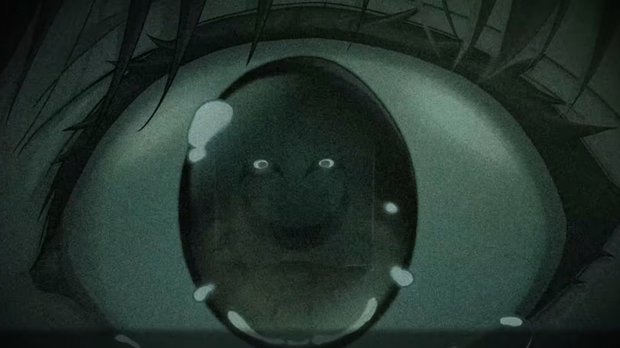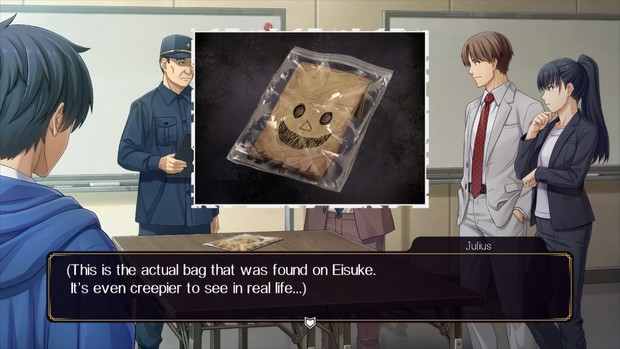Emio – The Smiling Man: Famicom Detective Club review

- 0 Comments
A deep and mature visual novel whodunit sure to bring a smile to fans of the thirty-year-old franchise
The legend of Emio – The Smiling Man tells of the last words his victims ever hear: “I can give you a smile that will last forever.” This is the chilling promise of the titular character in the new installment of the Famicom Detective Club series. Once you dive into its mysteries, you will find that this is not a detective story for the faint of heart. Yoshio Sakamoto, returning writer of the previous two games and co-creator of the Metroid franchise, weaves a bold tale that aims to cover historically taboo ground with topics like trauma and domestic violence. While the structure of this experience does little to innovate on previous entries in terms of their traditional visual novel gameplay, the story largely succeeds in creating a genuine sense of dread, even with a few stumbles along the way in its 10-12 hour runtime.
Like many others who saw the cryptic teaser dropped by Nintendo ahead of the game’s official announcement, I was unsure what to make of the eerie figure wearing a paper bag with a crude smile scribbled on its surface. But also like many others, I was absolutely captivated by the possibility of something fresh and exciting to come out of a typically family-friendly company like Nintendo. Once the title was revealed to be a new entry in a Japanese series that had not produced a proper sequel in decades, I was curious to see the direction it would take. The 2021 remakes (offering the first official English translations) of the first two games, while impressive, were the same stories originally told thirty years ago. With this new entry being created from the ground up, this would be an experience unbound by the need to remain faithful to existing source material.
As a visual novel, The Smiling Man is very conventional in its approach to gameplay. If you are accustomed to the format, the gameplay here is nothing new. You progress the narrative by choosing from a variety of contextual pop-up text options, listed on a task bar highly reminiscent of the one that appeared in both Famicom Detective Club remakes of The Missing Heir and The Girl Who Stands Behind. The task bar appears on the left of the screen whenever you’re given control of how to progress, with the available options to “Call/Engage,” “Ask/Listen,” “Look/Examine,” “Take,” “Use Phone,” “Think,” “Open Notebook,” or “Save/Quit Investigation.” While some quality-of-life additions have been made (certain words will be highlighted in conversations to indicate a possible next step), the gameplay remains largely the same. This generally works smoothly, though there were multiple scenarios where the game kept indicating I needed to choose an option to do something when engaging with a character about what they saw in relation to the case, only to find that I had to select the same option multiple times when there was no indication that doing so would progress the plot further.

While most of the gameplay is driven by menu choices, using the “Look/Examine” option allows you to scan the current screen with your cursor like a standard adventure. You will almost certainly come upon a situation at least once where you’ve chosen all possible options in your toolbar repeatedly, only to find that you failed to notice that looking at the face of the individual you’re speaking with is an option. (I believe this is required at least three times over the course of the game.) I appreciate the developers attempting to bring some variety to the gameplay, but the game uses “Look/Examine” infrequently enough that I genuinely forgot it was an option at multiple points.
While bare bones, the interface gets the job done and is serviceable enough to support the real star of the show: the story and dialogue. The Smiling Man begins in a fashion that immediately feels familiar for the Famicom Detective Club. You play the role of the returning late-teen male protagonist from the previous two games (whose name you can import from your previous save data from The Missing Heir or The Girl Who Stands Behind if you have either or both games on your Nintendo Switch console), who works as an assistant private investigator with the Utsugi Detective Agency in early 1990s Japan. The story starts when you receive a call from Police Inspector Kimiharu Kamada requesting a new set of eyes on a crime scene. Shortly after arriving, you find the reason for your summons to be that the body of junior high school student Eisuke Sasaki has been found with a paper bag slipped over his head, echoing a mysterious cold case your mentor Shunsuke Utsugi and Inspector Kamada have deep ties to. Kamada has enlisted the help of the Utsugi Detective Agency to get to the bottom of what happened.

This introduction to the setting and characters works well, especially if you are unfamiliar with the typical vibe of the series. While there are not many recurring characters from previous entries, notable returns include both Utsugi and fellow investigator Ayumi Tachibana. Ayumi represents the most significant change, as this is the first time she has been a fully playable character in the main series entries (though she was in the Japan-only Satellaview-exclusive mini-entry BS Tantei Club: Yuki ni Kieta Kako). Ayumi plays identically to the main character, but most of her sections are ultimately less impactful to the overall investigation, leading to a sense that they’re serving as filler between major reveals. This is a shame, as Ayumi’s character is just as likeable here as she was in the earlier games. While I am glad that she makes a return in a playable capacity, I would have liked to see her have a larger role in the overarching narrative.
As before, you will meet a wide variety of colorful characters as you progress through the plot. The characters all have believable motives, with several arcs that genuinely surprised me. Standout new faces include detective partners Junko Kuze and Daisuke Kamihara; Kuze appears cold and by the book, while one of the first things you hear about Kamihara is Kuze scolding him for arriving late to a crime scene after suspecting that he had been knocking back a few drinks before driving over. Kamihara ended up being my favorite character by the end of the game and has some incredible moments that made any section involving him a genuine treat.
There is one location in particular that provided some of my favorite experiences in the game: a tiny hole-in-the-wall establishment called Shoko Bar. It helps humanize the story in a way that feels refreshing and real, as the owner is just someone trying to get by while doing something she genuinely loves. This feeling of mundanity permeates the majority of the places you visit, whether it’s walking up to a small mom-and-pop car repair shop that’s been in business longer than the protagonist has been alive, waiting at a bus stop where the bus never seems to run, or being scolded by a retirement home receptionist for showing up at their facility without an appointment. It’s moments and locations like these that give the story a feeling of believability that makes the threat of a killer inhabiting this world all the more impactful.
Unfortunately, not all subplots have the same level of finesse, which can lead to inconsistent pacing and tone in some sections, especially early on. This is particularly apparent with a love triangle the game desperately wants you to feel invested in but ultimately goes nowhere and has little to no bearing on the broader narrative. It doesn’t help that the main case is a slow burn in its own right, which can cause these digressions to feel especially egregious. There were multiple times I audibly groaned when I saw the scene being loaded was the coffee shop where most of this subplot plays out.

Where the game most brilliantly shines is in its phenomenal storytelling of the core mystery. The urban legend of a masked killer feels frighteningly real, and characters react to it in believable ways. Children try to scare each other by wearing paper bags to mimic his look, reminiscent of sleepovers when I was a kid where we would try to summon Bloody Mary while staring deep into a dark bathroom mirror. Adults ask you uneasily if the rumors of a masked killer are true, and you see in their pained expression that they are very hopeful that you will tell them it’s all a big hoax cooked up by the media. It is incredibly apparent that this story comes from someone who has been honing their craft in the industry for thirty-plus years since the last mainline series entry, and I can happily say this is easily my favorite plot of the three. Certain sequences can feel drawn out at times, and your presence as a driving force of the narrative can come across as largely inconsequential overall, but even so, The Smiling Man succeeds in spinning a satisfying piece of detective fiction.
A large part of why many of the story beats are so effective is due to the terrific voice performances provided by the returning cast of the 2021 remakes. Like in those games, the acting in The Smiling Man is entirely in Japanese. But even with my complete inability to understand the words being spoken out loud, the cast provide an emotional depth to the written dialogue that greatly enhances the experience. The music is also top notch: several tracks pay homage to previous entries, and when the drama intensifies the music follows suit. The soundtrack is handled through a beautifully crafted synthesized score that is upbeat and cheerful with funky basslines as you walk about town questioning people, along with fittingly haunting piano keys and echoing bells when the plot demands an emotional resonance. There isn't a huge variety of tracks, but the ones that are here are great and serve their intended purpose.
The anime-inspired, slideshow-style visual presentation is stunning. At first glance I thought the character portraits were still images with mouth movements edited in, but when I noticed the characters were breathing or that the wind moved their hair, I was blown away. The game takes place in the early '90s, and the details and style all evoke this era. You are given a cell phone the size of a brick early on, and the protagonist is overjoyed at having something so technologically advanced at his disposal after being forced to find a landline to make a call in previous games. Glancing at the backgrounds you will see Ayumi’s chunky early generation laptop while checking in at the Utsugi Detective Agency or the news being broadcast over a huge CRT TV while you’re questioning someone about the case in their home. The 2D backgrounds and objects you can hover over for additional details of are all beautifully designed and work to create a cohesive look. Anyone who has played the previous remakes will immediately recognize the graphical style, but The Smiling Man feels much more polished overall.
Without giving anything away, the ending is bold in a way few games in Nintendo's extensive library are, which even Sakamoto acknowledged may be divisive. Initially I was confused, feeling like I missed something along the way that would have given me a better sense of closure, or that I must have gotten a bad ending somehow. (I didn’t; there is only one ending.) Everything is wonderfully tied together in the finale, but it is presented in a way that made me wish I could have pieced more of the core mystery together over the course of the game rather than having my questions answered all at once. It never felt like I had enough pieces of the puzzle to make the ultimate deductions on my own. And yet I think that is partially the point that Sakamoto is trying to make: sometimes there just aren’t more pieces to find, and even the best detectives will be left with a few gaps in their deductions. I felt generally satisfied after seeing the credits roll, but I am positive there’ll be debate about the ending, and one’s appreciation of it will largely come down to personal preference.
Final Verdict
Emio – The Smiling Man is exactly as advertised: It is the first new entry in the Famicom Detective Club visual novel series in decades, justifying the revival with a strong hook that sinks its teeth into you and will keep you guessing throughout. The gameplay is largely identical to previous entries, and if you liked the first two titles in the franchise, you will surely enjoy what's on offer here as well. It's disappointing that the game isn't more tonally consistent across all its narrative strands, but when the story is focused on its core investigation, it really excels. The reveals in the latter half of the game could have been more evenly spaced out to better feel like you were uncovering the mystery, but the case itself is so compelling and the writing so good that this is nevertheless a satisfying adventure with a conclusion that will remain with you long after you’re done.
Hot take
Emio – The Smiling Man is a haunting tale that marks a welcome return of the Famicom Detective Club series. It’s the best of the three so far and steers significantly darker than previous entries, though as a visual novel with limited gameplay, it won’t change any minds if you weren’t already on board with what’s on offer.
Pros
- Well-written detective drama
- Gorgeous animations and backgrounds create a distinctive look
- Believable characters with unclear motivations that keep you guessing
Cons
- Outdated interface that leads to some trial-and-error gameplay
- Subplots are tonally inconsistent with the core mystery
Sam played his own copy of Emio – The Smiling Man: Famicom Detective Club on Nintendo Switch.











0 Comments
Want to join the discussion? Leave a comment as guest, sign in or register in our forums.
Leave a comment